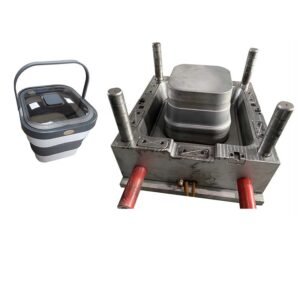Welding line of overmolding of injection molded parts. The molten plastic in the mold cavity converges in multiple strands due to the holes of the insert, the area of discontinuous flow rate, and the area of interrupted filling material flow. This low-temperature molten material converges in the form of linear welds because it cannot be completely fused. In addition, welds are also generated when the gate injection molding occurs. This weld mark only occurs at the molten material convergence point (using one gate, the product that does not make the material merge from two directions generally has no weld mark), that is, it only occurs in parts with holes or parts molded by multiple gates, where the strength is lower than other parts. The weld mark of parts such as grids appears in the center, which affects the strength and appearance. The distinction between weld marks and cracks can be distinguished by applying ink on the product; with this phenomenon, flash is also likely to occur at the weld mark. This means that the pressure of the material has reached a higher level at the weld mark. Because of this, dents rarely occur at the weld mark. If you want to avoid weld marks, you can only change the position of the gate so that the weld marks occur in an inconspicuous or pleasing position. The pins on the mold (holes on the product) generally have weld marks. There is also a method: make the place where the weld marks occur on the excess thin sheet of the product, and then cut off the thin sheet. The details of the weld marks are described as follows:
1. Mold: The location where the weld mark occurs is related to the gate and the shape of the product. When it cannot be eliminated, it should be moved to a position that does not affect the appearance quality. For this reason, if there are too many gates in the same cavity, the gates should be reduced or set symmetrically, or set as close to the weld seam as possible; the exhaust at the weld seam is poor, and an exhaust system should be opened; the runner is too large, the size of the pouring system is inappropriate, and the gate should be opened to avoid the melt flowing around the insert hole, or use as few inserts as possible; the wall thickness changes too much, or the wall thickness is too thin, the wall thickness of the product should be uniform; if necessary, an overflow trough should be opened at the weld seam, and it should be cut off and removed after molding or designed to be automatically detached.
2. Process: Injection pressure and speed are too low, barrel temperature and mold temperature are too low, causing the molten material entering the mold to cool prematurely and form a weld seam; when the injection pressure and speed are too high, there will be jetting and a weld seam; the rotation speed should be increased, and the back pressure should be increased to reduce the viscosity of the plastic and increase the density; the plastic should be dried well, and recycled materials should be used less. Excessive use of release agent or poor quality will also cause weld seams; reduce the clamping force to facilitate exhaust.
3. Plastic: Insufficient melt fluidity If the melt fluidity is insufficient, the melt temperature at the weld will be lower, and the pressure loss will also be large, which will inevitably make the weld mark obvious and the strength decrease; the measures are to increase the melt temperature to improve the fluidity; speed up the injection speed so that the melt reaches the confluence without cooling, increase the mold temperature to reduce the cooling of the melt; expand the gate or thicken the wall thickness of the part on the path to the confluence to reduce the flow resistance. Using plastics with good fluidity is conducive to reducing weld marks. Weld marks will definitely appear when multiple gates are used for molding, but when a single gate can be used for molding, weld marks may not appear. Lubricants and stabilizers should be added appropriately to plastics with poor fluidity or heat sensitivity; plastics containing many impurities should be replaced with better quality plastics if necessary.
4. The presence of air or volatile components Although weld marks are inevitable as mentioned above, air or volatile components should be removed first when the molten material flows. If the exhaust is not smooth, the weld marks will of course become obvious. In severe cases, this situation will also cause insufficient filling or burns (refer to insufficient filling, burns); considering this possibility, it is necessary to use the gap of the insert to exhaust or set exhaust ducts. The weld marks caused by air are exactly the opposite of the usual method of eliminating weld marks. Sometimes it is even necessary to reduce the injection speed to make the weld marks less obvious.
5. Release agent causes When the mold cavity surface is coated with a release agent, once the molten material is transported to the weld, the release agent and the molten material do not fuse with each other, resulting in weld marks. This phenomenon is more serious when using a silicone release agent. If this weld mark is coarse and heavy, it often makes the part fragile and easy to crack (refer to fragile).
6. Colorant Causes If aluminum foil or micro-particle colorant is added to form a disc, the weld mark will obviously change with the properties of the colorant. It is difficult to eliminate this weld mark (refer to color unevenness).

